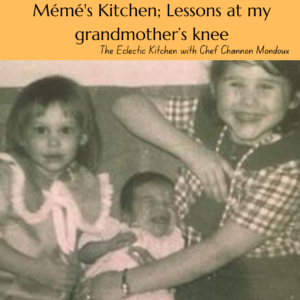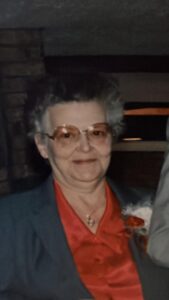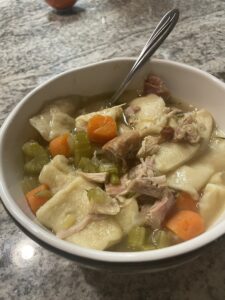
Some of my earliest memories are pre-verbal: looking up at the table’s edge, seeing my Memé with her ancient white crockery bowl with the red band, wooden rolling pin dangling precariously near the edge. A dusting of flour wafts down through the air as she mixes and kneads the dough within it. And me, desperately wanting to roll the dough, fat fingers pointing, pigtails bouncing as I just can’t contain my excitement at the thought.
The morning light filters into the kitchen window through lace curtains. “C’mon, up!”Memé quips in her thick French- Canadian accent, as she lifts me onto the green paint-chipped chair. By now, she has already rolled the dough but she lets me hold the knife and helps guide me to cut it into giant Sliders, the squares of dough that will soon slip and slide like their namesake on our plates and into our bellies. Poppie, a French-Canadian colloquialism for Pot Pie, is a hearty dish of chicken stew with large, flat and square noodles also known as Sliders or “Glissant” (slippery).
Until I was an adult, I had conflated the name of this dish with the spinach-swizzling, early Americana superhero, Popeye. I used to wonder if he ate Chicken and Sliders like we did, only maybe out of a can like his spinach. As Memé would show me how to make the dough, she said “Like this” a lot (except she said “Like dis”), and that meant the dough had to look, or feel a certain way.
She would pinch her earlobe, gesture for me to do the same, and then have me pinch the dough to make sure it was just right. I am forever grateful to my Memé for the patience and love she shared through her kitchen with me.

This lesson (and many others just like it) was foundational. Not only did it teach me to learn to cook by feel, but it allowed me to develop skills in understanding how texture and flavors combine without cooking from recipes.
It also grounded me to trust myself, my own tactile senses, the reality of the food and its relationship to me, not just words on a page. This has been my foundation to develop an intuitive sense of how to put food together, a skill that lent itself well to my work in culinary history. It is also how I teach others.
Poppie (Chicken and Glissant/Sliders) in action
After the dough was rolled, we had to boil the noodles in stock, and in our house that meant hauling out the enormous baby bath-sized pot from the pantry. Our kitchen stove was a simple, white four burner enameled gas dinosaur, probably purchased in the 1950’s. This unpretentious contraption pumped out three squares a day for anywhere from seven to 10 of us—and often, the older kids would come home and add another 4-6. It was a workhorse and it stood stoically in the middle of the wall. No counters on either side, you had to stand there and hold the bowl to drop each sheet of pasta into the bubbly stock.
Mémé would pull a stool over to the side of the stove and she would hold a plate with a pile of the big, square noodles on it, heavily dusted with flour to keep them from sticking. And one by one, she would drop them in the pot—and she let me stir this enormous pot with an equally enormous spoon (if you don’t stir, they stick to each other en masse). Reflecting back on those earliest memories, I was probably two, maybe three years old? Today, someone would have called child protective services had they seen me perched precariously on that stool, stirring a boiling pot of soup. I laugh now, but as a mother of three, I can understand the concern. As I grew older and stronger, I began to stand at her side, holding the plate myself while she stirred. Eventually, she just handed me the plate and I knew what to do. Her trust in me built confidence—and in turn, I have always helped my youngest students to really cook. Not just mash around food using plastic knives but carefully and methodically, teaching them greater and greater responsibility in the kitchen.
When I asked my Mémé to help me write down the recipe for this many years later, I was greeted with this off the wall response: “How many people are you cooking for?” I stared at her blankly. “Umm, I don’t know? Like how many do YOU make it for?” She looked back at me and matter of factly said, “You tell me how many people you’re cooking for, and I’ll tell you how to make the dish.” At that point, I got it, she wasn’t using a standard recipe, she wasn’t cooking for her own table. She cooked like many chefs do; they know the formula and once they have one of the factors, they adjust the rest of the equation to match. Can I add that cooking helped me pass 11th grade math? So, I picked a number “Four. Let’s say I am cooking for four.”

I took my pad of paper and pen and poised to write this epic recipe. “You take one chicken, and you put it in the pot and salt and pepper.” She gestured sprinkling some over the pot. “Once it’s cooked (I assumed browned), you pour water over it and put in bay leaves. You cut up carrots,onions, and celery and you put them in the pot, too. You cook it until they are done. Then you make your dough. For every person you are cooking for, you use one cup of flour, one egg, and this much salt (she showed me her pinched fingers) and some water. Then you cook the dough in the pot with the chicken.”
No more, no less. That was the recipe she left me with. Simple, austere, hearty and incredibly inexpensive to make for a dinner table that regularly hosted 7-10. If you had 10, you all got a bit less chicken. Mind you, if you hadn’t seen someone make it, you might be intimidated to interpret it. It is a recipe I’ve grown to appreciate for its rustic nature that I have played with and embellished. You’ll find my recipe for Chicken ‘n Sliders (Glissant) aka Poppie in the conventional recipes section.
This kind of verbal instruction opened my mind to the idea that recipes are suggestions. They are fluid, not static—and like the story above, they change with time and experience. And many years later when I encountered my first medieval recipes, I was spellbound. That experience and more will come as I share with you my kitchen stories.
Feature photo: Me (age 4) and my little sisters Tammy (age 2) and Kimmy (newborn)